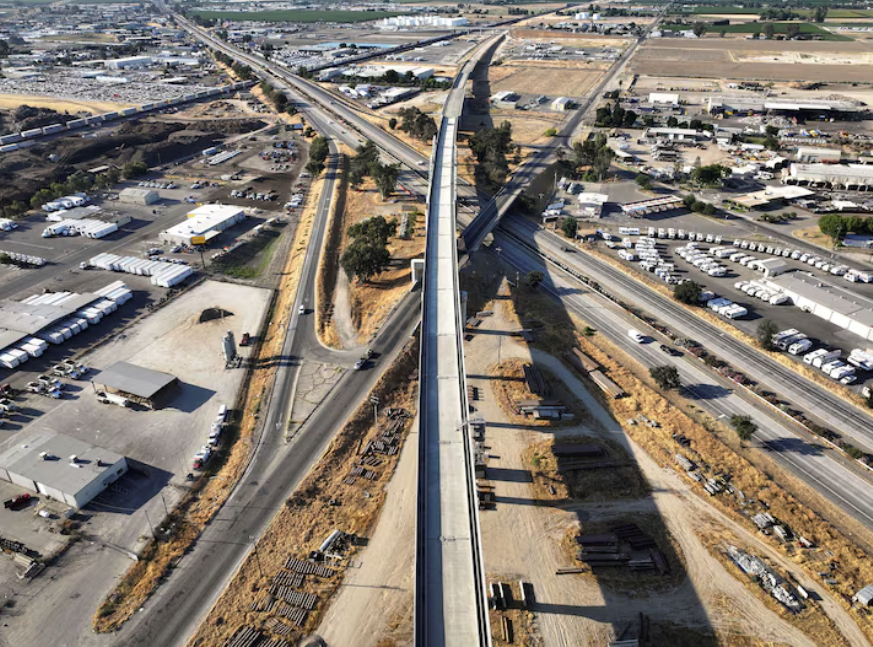
On July 16 local time, U.S. President Trump posted on his social media platform that the federal government would no longer provide any funds for the California high - speed rail project, calling it a "catastrophic, severely over - budget 'high - speed rail to nowhere'". This decision has undoubtedly dealt a heavy blow to the California high - speed rail project, which has gone through many twists and turns over the years.
In his statement, Trump accused California Governor Newsom of incompetent leadership, saying that the project has cost hundreds of billions of dollars but "has never kept its promises and will never be delivered". In fact, the California high - speed rail has faced many difficulties since its planning. The project was confirmed in 2008 after California voters passed the "High - Speed Rail Act". It aims to connect San Francisco and Los Angeles, which are at the north and south ends of California, with a straight - line distance of about 600 kilometers between the two cities. If completed, it will become the first high - speed rail in the United States and the country's most ambitious green transportation project.
However, a report released by the U.S. Department of Transportation in early June this year showed that the California high - speed rail project has a series of problems such as construction delays and poor management. In the 17 years since the passage of the 2008 Act, the project has spent 16 billion U.S. dollars, but not a single track has been laid yet. The report also required the California High - Speed Rail Authority to respond by July 11, otherwise about 4 billion U.S. dollars in additional funding would be cancelled. Now Trump has directly announced the termination of funding support, making the prospects of the project even more bleak.
The slow progress of the California high - speed rail project is affected by multiple factors. Firstly, it is difficult to acquire land for farms. Railway construction requires a large amount of land, and in California, the process of acquiring land involves complex property rights issues and interest games, leading to slow progress in land acquisition. Secondly, the project has to deal with many environmental lawsuits. Due to California's extremely high requirements for environmental protection, every link in the construction of the high - speed rail may face lawsuits due to environmental issues, which has greatly delayed the progress of the project. In addition, the United States lacks experience in high - speed rail construction. Compared with other countries, the United States lacks a mature system in high - speed rail technology, project management, etc., and has continuously encountered technical problems and management difficulties during the construction process.
Despite facing numerous difficulties, the successful completion of the California high - speed rail will be of great significance. It is estimated that it will reduce carbon dioxide emissions by 1.5 million tons per year, which is equivalent to reducing 300,000 cars on the road. It will play an important role in helping California get rid of the carbon - intensive travel mode dominated by cars and short - haul flights and become a pioneer in the field of clean energy transportation. Therefore, the California high - speed rail is known as one of the "symbolic projects" of the United States' green transformation.
In the face of Trump's decision, reactions from all parties are mixed. Some environmental experts said, "High - speed rail is not a short - term financial gain project, but a representative of climate responsibility investment. If it is abandoned due to political pressure, it will deal a major blow to the confidence in green infrastructure across the country." However, the persistence of environmentalists is difficult to resist the realistic challenges. The delay in local land acquisition, the frequent replacement of contractors, the tight financial situation of the state government, and the public's doubts about "whether the half - built railway can be put into operation" have made the supporters proceed cautiously. A poll at the beginning of 2025 showed that more than 53% of California voters "have lost confidence in the high - speed rail project", and only 28% believe that "it will eventually be completed and put into use".
At present, about one - third of the funds obtained by the California high - speed rail project come from the federal government, mainly through the "Infrastructure Investment and Jobs Act" and the "American Recovery and Reinvestment Act". The Biden administration added more than 3 billion U.S. dollars between 2023 and 2024 to support the construction of the central section. But now the latest statement from the Trump administration has undoubtedly made the project face greater uncertainty. If the federal government withdraws its funds, not only will the "Central Valley" section be likely to be "unfinished", but the progress of the subsequent Los Angeles - Anaheim and San Francisco Bay Area sections will also be completely stagnant. A project spokesman said in response to the media, "We are used to building this railway in the face of political headwinds."
The California high - speed rail project, from planning to the current funding dilemma, reflects many institutional and social problems faced by the United States in the process of large - scale infrastructure construction. In the future, the fate of the project, whether it will continue to struggle in difficulties or completely fail, is being watched by the whole world.

Due to the decline in imports, the trade deficit of the United States narrowed to the smallest since 2009 in October last year.
Due to the decline in imports, the trade deficit of the Uni…
Iran's state media reported on Thursday (January 8) that Ir…
German Foreign Minister Waldorf condemned Iran's excessive …
South Korean President Lee Jae-myung will pay a two-day sta…
US President Trump claimed that his "own moral code" was th…
On January 7th local time, GameStop (GME.US) announced that…